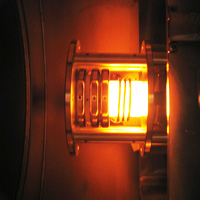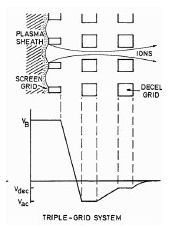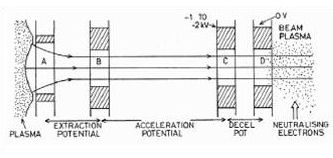Dual-stage Gridded Ion Thruster (DS4G)

Electrostatic grid systems used in conventional state-of-the-art ion thrusters perform ion extraction and acceleration simultaneously in a single-stage process, typically using 2 or 3 permeable grids closely spaced in series. This ultimately limits achievable performance in terms of power density, thrust density, exhaust velocity, and specific impulse because the inter-grid potential must be limited in order to avoid excessive penetration of the grid electric field into the discharge chamber containing the plasma. The resulting effect of this penetration is a curvature in the plasma sheath (or meniscus) attached to the holes in the screen (first) grid (see Fig. 2). The higher the beam potential (VB), the greater the curvature, and hence the greater the extracted ion beamlet divergence, until significant direct ion impingement occurs on the acceleration (second) grid and deceleration (third) grid.
Problem statement

Direct impingement of energetic ions causes sputtering of the grid material, leading to excessive grid erosion (essentially hole widening), performance degradation and eventually limitation of thruster lifetime. In order to avoid beamlet divergence, impingement and sputtering, grid potential is limited to about 5 kV in present systems (usually much less). Practically, this limits the achievable specific impulse to <10,000 s, thrust density to <0.5 mN/cm2, and power density to <20 W/cm2 with Xenon propellant. Due to these performance limits and thermal/mechanical constraints placed on the thin, closely spaced grids, present gridded ion thrusters operate at powers of up to 40-50 kW maximum with beam apertures of up to order 50 cm diameter. The limit on specific impulse does not have an impact on missions to bodies in the inner solar system or those out to Jupiter, since typically their optimum values are lower than this maximum for reasonable mission durations (e.g. 2,000-6,000 s for Mars round trips, 8,000-10,000 s for Jupiter Icy Moon Orbiters). However, it is evident that missions to the far outer solar system and beyond will need specific impulse values well beyond 10,000 s up to about 50,000 s or more in order to ensure propellant mass fraction does not dominate the spacecraft mass budget for the high delta-V concerned (30-100 km/s). Future interstellar missions well beyond the heliopause to 1,000-10,000 AU will require specific impulses as high as 100,000 s.
The limits on power density and thrust density severely affect the suitability of GITs to higher power robotic and human missions to any destination however. The only method to deliver the N-level thrusts required for larger payload missions with these limits is to increase the beam aperture area and hence the thruster diameter. Unfortunately, due to thermal and vibration constraints, the thin grids have a maximum diameter of about 50 cm. Due to these constraints, present gridded ion thrusters operate at powers from 1-40 kW and thrusts the 10-1000 mN range, and their absolute limit is considered to be 40 kW. This leads to the necessity of using a large module integrating a cluster of thrusters with a number of power processing units for missions in the 100 kW-MW class, thus leading to a high propulsion system mass and volume. Taken to the extreme, a human Mars mission using EP would require about 8-15 MW power and deliver a thrust of 9 -180 N. Using conventional gridded ion thrusters (or Hall effect thrusters) limited to 50 kW power would require some 160-320 thruster units each of 50 cm diameter. Even using the alternative approach of spacing multiple-aperture grid systems over the interface with a single large area discharge chamber to extend thruster power levels to the 100 kW range still results in a very large thruster, and does not reduce the mass and volume substantially. For this reason, alternative propulsion technologies able to accept higher power and thrust within a compact device and deliver moderate/high specific impulse are being investigated for the 100-1000 kW mission class. Examples include Magneto-Plasma-Dynamic (MPD) and Helicon RF Plasma thrusters (e.g. VASIMR or HDLT). If the performance limitations of present gridded ion thrusters imposed by the single-stage extraction/acceleration process could be removed, then new classes of future space missions could be enabled and propulsion system mass/volume considerably reduced for existing mission classes. In achieving this breakthrough, we may look to the Controlled Thermonuclear Reaction (CTR) research community for inspiration. For over 20 years, ion sources, coupled with charge-exchange gas cells, have been used to inject highly energetic neutral particles (80-100 keV) into fusion reactor experiments [1-5]. These ion sources are remarkably similar in design to gridded ion thrusters (without external neutraliser) with the exception that they use 4-grid systems in order to achieve extremely high ion velocities with light gases such as hydrogen (see Fig. 3). This 4-grid configuration allows the ion extraction and ion acceleration processes to be decoupled, essentially creating a dual-stage system.
Dual-Stage Ion Thrusters

In the first stage, ions are extracted from the plasma sheath with the potential limited to <5kV for preventing beamlet curvature, divergence and impingement problems, and then in a second stage they are accelerated to much higher velocities with acceleration potentials of up to 80kV. The CTR dual-stage ion sources were only 10-40 cm in beam diameter, but managed to process input powers from 250kW to 4.8MW and accelerated ionised hydrogen to exhaust velocities of up to 4,000 km/s. One of the maximum cases recorded experimentally was at the Culham Laboratory, Oxford, UK with neutral atomic beam injectors developed for the JET tokamak [5]. Extremely high power densities of 6670 W/cm2 were achieved.
A further benefit of the dual-stage system is a very low beam divergence of about 0.4-2 deg only due to the strong acceleration of the second stage, thus reducing further any possibility of adverse thruster-spacecraft interactions, and also reducing attitude control demands when compared to other thrusters. Present gridded ion thrusters have typical divergence of 12-15 deg, and Hall effect thrusters about 40 deg. In recent papers published by Fearn [6,7], the theoretical application of a dual-stage 4-grid electrostatic system to gridded ion thrusters was investigated. Taking into account safety margins such as a low perveance factor to ensure a low probability of direct ion impingement and long grid life, it was calculated that a single 20 cm diameter gridded ion thruster could operate at 250 kW power to produce a 2.5 N thrust and a specific impulse of 19,300 s from Xenon propellant using a 4-grid system with 30 kV beam potential and 1 mm ion extraction grid separation. If proven experimentally, this would represent a significant step forward in propulsive performance over the state-of-the-art, extending maximum power to the 100-500 kW range and making gridded ion thrusters very competitive with other high power thrusters such as MPD thrusters and helicon plasma thrusters such as VASIMR, which still require considerable R&D to understand the underlying physics and considerably improve their presently low thrust efficiency. Gridded ion thrusters have a long heritage and are inherently simple, well understood devices, hence minimizing development effort needed to prepare for effective flight operations in space. Operating at a 30 kV beam potential, this concept would increase the specific impulse by a factor of 2, thrust density by factor 20, and power density by factor 40 over the maximum achievable performance of the current state-of-the-art gridded ion thrusters.
Further reading
References
- Kim, J., W. L. Gardner, and M. M. Menon. 1979. "Experimental study of ion beam optics in a two-stage accelerator." Rev Sci Instrum, 50, 201-206.
- Okumura, Y., et al. 1980. "Quasi-DC extraction of 70 keV, 5 A ion beam." Rev Sci Instrum, 51, 728-734.
- Y. Ohara. 1978. "Numerical simulation for design of a two-stage acceleration system in a megawatt power ion source." J Appl Phys, 49, 4711-4717.
- Menon, M. M., et al. 1980. "Power transmission characteristics of a two-stage multiaperture neutral beam source." Rev Sci Instrum, 51, 1163-1167.
- , A. R. Martin. 1984. "High power beams for neutral injection heating." Vacuum, 34, 1-2, 17-24.
- D. Fearn. 2003. "The Prospects for MW Power Level Gridded Ion Thrusters." In 10th International Workshop on Combustion and Propulsion: In-space propulsion, Lerici, La Spezia, Italy, 21-25.
- D. Fearn. 2005. "The Application of Gridded Ion Thrusters to High Thrust, High Specific Impulse Nuclear-Electric Missions." Journal of the British Interplanetary Society, Vol. 58, No. 7/8, pp. 257-267.